Art School á la mode
In the realm of fashion, there are some
distinctions to be made.
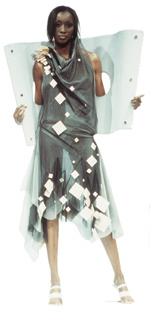 There’s
fashion, and then there’s Fashion: i.e., commerce is
to art what the Gap is to Givenchy. And yet neither is taken
as seriously as, say, painting or architecture, though fashion
is usually the medium that’s the clearest cultural indicator
of “the now.” Because its nature is indefinite
— think of the fluidity of silk versus the solidity
of brick — fashion rarely matters in Serious Art Discourse.
As Susan Sidlauskas wrote in the exhibition catalogue for
the Intimate Architecture exhibition of 1982, one of the first
exhibitions of costume in a museum, that “as a design
discipline, clothing routinely has been considered the frivolous
sibling to responsible architecture and pragmatic industrial
design.”
There’s
fashion, and then there’s Fashion: i.e., commerce is
to art what the Gap is to Givenchy. And yet neither is taken
as seriously as, say, painting or architecture, though fashion
is usually the medium that’s the clearest cultural indicator
of “the now.” Because its nature is indefinite
— think of the fluidity of silk versus the solidity
of brick — fashion rarely matters in Serious Art Discourse.
As Susan Sidlauskas wrote in the exhibition catalogue for
the Intimate Architecture exhibition of 1982, one of the first
exhibitions of costume in a museum, that “as a design
discipline, clothing routinely has been considered the frivolous
sibling to responsible architecture and pragmatic industrial
design.”
But when fashion meets art school,
where the edicts we see in Vogue are second to the power of
self-expression via one’s chosen media, the complexities
multiply: With a program that focuses more on studio expertise
than marketing lessons, fashion students at SAIC learn an
art and a trade at once. They create eccentric wearable art
and simultaneously amass solid garment-construction career
skills.
The extraordinary talent of 65 such
students was on display at the 2003 installment of the Fashion
Department’s annual runway extravaganza, which took
place last May in the SAIC Ballroom. Fashion 2003 featured
individual outfits by sophomores and collections of three
and five from juniors and seniors, respectively — on
professional models amid the kind of lights, music, video,
and sound that screams glamour. The models stalked the runway
in the exactly the same authoritative, one blink-and-you’ll-miss
it manner one imagines models do. 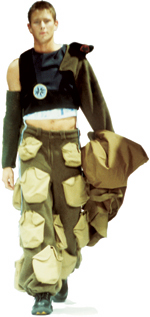
But the whirlwind splendor of the
show wasn’t nearly as stunning as the clothes themselves.
Without exception, they were marked by incredible craftsmanship
that could dazzle even the jaded intellectual, the fashion-clueless,
and the anti-materialist. As anyone who has ever so much as
hemmed a pair of trousers knows, the intricate beauty of couture
is easy to appreciate.
This is not to say that the majority
of designs were well-made interview suits or dresses for tea
with Grandma. These were clothes for iconoclasts. Incongruous,
yet brilliantly executed amalgamations of style were everywhere:
Coral Marie McLain’s long black satin and green ultrasuede
coat, paired with a nylon minidress and high stiletto boots,
topped with an orange nipple-pointed hat, looked elfin and
mod all at once. Abby Sturges bedecked the ’80s club
kid slumming at a tiki bar with an iridescent purple and green
“hula honey” dress. SiHyang Park’s tropical-chic
confections, alluring messes of pleats and gathers in Thai
silk and georgette, were 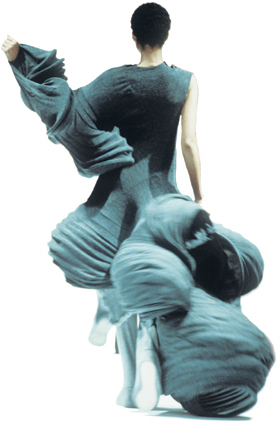 mesmerizing
in their intricacy, yet they conveyed a nonchalance that perfectly
exemplifies unstudied elegance.
mesmerizing
in their intricacy, yet they conveyed a nonchalance that perfectly
exemplifies unstudied elegance.
One of the most dynamically avant-garde
collections was by junior Lara Miller. Her garments, all made
of natural fibers, included a long, grey boned wool jersey
gown with bulbous growths that billowed around the model’s
body. Such extraneous shapes, which augment the body rather
than enhance or flatter it, were reminiscent of work by the
new wave of Japanese fashion that rocked the industry in the
’80s and ’90s, when designers like Rei Kawakubo
made clothes that move independently of the wearer. Miller
says she is concerned with the difference between motion and
animation: the former connotes action, while the latter entails
evolution.
Taking a more traditional, unabashedly
luxe route, Maja Haraslic combined red velvet and yellow upholstery
with square design detailing, notably a floor-grazing full
skirt and matching, high-collared fitted coat, while a bare
little camisole top kept the look youthful amid so much heaviness.
Others integrated tradition into innovation, re-working everyday,
utilitarian elements of clothing. Anna Fifer’s military-inspired
collection included a men’s design that redefined the
cargo pant. She added cartoonishly large, khaki envelope-like
pockets all over a pair of dark-green fleece trousers. She
paired them with a hooded coat screenprinted with an Israeli
flag, an undershirt trimmed with fringe, and a hand-knit arm
piece, infusing  soldierly
staples with irreverent wit.
soldierly
staples with irreverent wit.
R’amon-Lawrence Allen Coleman’s
designs are for the woman whose love of fine tailoring is
matched only by her confidence to wear leather panties and
a perforated face harness. Coleman, who graduated in June
with numerous design awards, presented five shockingly sexy
ensembles that also included sky blue crocodile-print embossed
bustier atop a floaty cotton pleated skirt. Fellow senior
Christopher Shields’ extremely wearable, yet no less
sexy collection, inspired by the graphic nature of Robert
Mapplethorpe’s work, especially “the idea of a
line that trails around 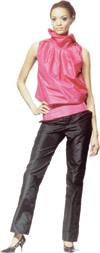 the
body,” recalled the ’80s in all the best ways:
vivid jewel tones, shimmering metallics, and severe, precise
tailoring juxtaposed with blouson tops.
the
body,” recalled the ’80s in all the best ways:
vivid jewel tones, shimmering metallics, and severe, precise
tailoring juxtaposed with blouson tops.
If any common threads (pun intended)
can be found in the whole of Fashion 2003, it is a concern
with structure, specifically with how the clothing relates
to the body. The architectural concerns of some designers
were particularly evident, including those of F News’
own art director Wilson Tjuatja Widjaja and senior Deirdre
Carrigan. Widjaja contrasted a nylon and mesh wisp of a dress
with the stuff of furniture and buildings: he embellished
the grey dress with white wood paillettes, and built a white
birchwood veneer vest lined in white leather, as well as strappy
sandals in gleaming steel and white leather. The stiffness
of the vest and square pailletes stood out starkly against
the fluidity of the dress, looking radically fresh.
Carrigan’s designs were inspired
by the work of Richard Nickel, a photographer and preservationist
of Chicago buildings who died on a salvage mission for abandoned,
demolished architectural treasures. Her boxy jumper and coats
juxtaposed with stripped and frayed under-layers are lyrical
interpretations of exploration of a decaying structure. Thus
Carrigan’s clothes create an intriguing complication
of the links between fashion and architecture.
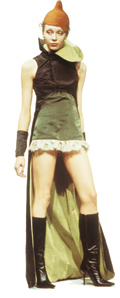 Of
this dichotomy, fashion historian Holly Brubach has said that
fashion represents a feminine aesthetic and architecture a
masculine one:
Of
this dichotomy, fashion historian Holly Brubach has said that
fashion represents a feminine aesthetic and architecture a
masculine one: 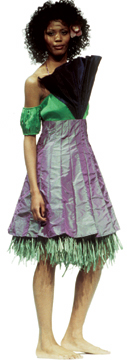
“Architecture has been revered
and accorded a place in the history of art, [and] fashion
has been dismissed as inconsequential. Buildings, made of
concrete and stone, are ‘permanent,’ while clothes,
made of fabric, are ephemeral. Architecture’s scale
is public, while fashion’s is intimate. Architecture
is high-minded and serious; fashion, mindless and capricious.”
If art itself has traditionally been
ruled by patriarchy, Carrigan and her SAIC fashion compatriots
are set to turn Serious Art Discourse on its head with an
often-dismissed medium to consider.
 There’s
fashion, and then there’s Fashion: i.e., commerce is
to art what the Gap is to Givenchy. And yet neither is taken
as seriously as, say, painting or architecture, though fashion
is usually the medium that’s the clearest cultural indicator
of “the now.” Because its nature is indefinite
— think of the fluidity of silk versus the solidity
of brick — fashion rarely matters in Serious Art Discourse.
As Susan Sidlauskas wrote in the exhibition catalogue for
the Intimate Architecture exhibition of 1982, one of the first
exhibitions of costume in a museum, that “as a design
discipline, clothing routinely has been considered the frivolous
sibling to responsible architecture and pragmatic industrial
design.”
There’s
fashion, and then there’s Fashion: i.e., commerce is
to art what the Gap is to Givenchy. And yet neither is taken
as seriously as, say, painting or architecture, though fashion
is usually the medium that’s the clearest cultural indicator
of “the now.” Because its nature is indefinite
— think of the fluidity of silk versus the solidity
of brick — fashion rarely matters in Serious Art Discourse.
As Susan Sidlauskas wrote in the exhibition catalogue for
the Intimate Architecture exhibition of 1982, one of the first
exhibitions of costume in a museum, that “as a design
discipline, clothing routinely has been considered the frivolous
sibling to responsible architecture and pragmatic industrial
design.”

 mesmerizing
in their intricacy, yet they conveyed a nonchalance that perfectly
exemplifies unstudied elegance.
mesmerizing
in their intricacy, yet they conveyed a nonchalance that perfectly
exemplifies unstudied elegance.  soldierly
staples with irreverent wit.
soldierly
staples with irreverent wit.  the
body,” recalled the ’80s in all the best ways:
vivid jewel tones, shimmering metallics, and severe, precise
tailoring juxtaposed with blouson tops.
the
body,” recalled the ’80s in all the best ways:
vivid jewel tones, shimmering metallics, and severe, precise
tailoring juxtaposed with blouson tops.  Of
this dichotomy, fashion historian Holly Brubach has said that
fashion represents a feminine aesthetic and architecture a
masculine one:
Of
this dichotomy, fashion historian Holly Brubach has said that
fashion represents a feminine aesthetic and architecture a
masculine one: 